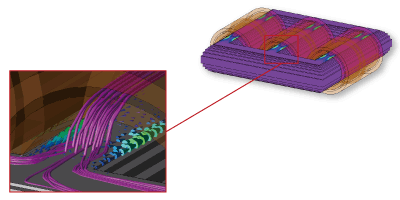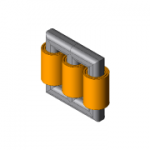Power Transformer
Problems associated with power transformers are not only related to design matters such as satisfying basic characteristics, but also includes many issues related to testing and maintenance. For example, magnetic flux leakage accompanying increased capacity causes localized stray loss in the tank. A coil’s dielectric strength needs to be verified by a local maximum electric field. The part arrangement between core and coil or magnetic flux distribution also has an effect on vibration caused by the electromagnetic force.
JMAG enables the visualization of the phenomena and ease in moving forward with analyzing causes. It also makes possible quantitative evaluations of temperature rising inside objects or noise where measurement is difficult.

Evaluation Items
Magnetic saturation, eddy current, induced voltage, stray loss, iron loss, magnetostrictive force, power, efficiency, temperature, electric fields
Case Studies / Functions
Stray Loss in the Iron Core
The following illustration shows the loss distribution of the iron core in a short circuit test. It can be observed that the leakage flux from the coil end enters perpendicularly to the plane of the steel sheet resulting in eddy currents generated on its surface. This leakage flux causes local heat generation during operation. By applying anisotropy to magnetic properties and electric conductivity, the behavior of magnetic flux and eddy currents in the laminated iron core can be correctly captured.

Iron Loss Distribution in the Core
Transformer cores sometimes use anisotropic materials which have different material properties in different directions. In a laminated iron core transformer, material isotropy has an impact on losses. In this example, the transformer has a V-notch to join the different leg and yoke components. The analysis shows that iron losses concentrate at these intersections.

Iron Loss Distribution in the Core
Not only confirms iron loss distribution generated in a core geometry, but also capable of separating hysteresis loss and joule loss making up iron loss to evaluate the contribution of each.

JMAG’s function: Anisotropic Magnetic Properties
Defines magnetic and iron loss characteristics in both easy and hard magnetization directions for directional magnetic steel sheets.

Evaluating Magnetic Flux Leakage and Stray Loss
By getting an accurate grasp of the magnetic flux leakage difficult to evaluate in a magnetic circuit, it becomes possible to evaluate stray loss generated in a tank wall. Examining the loss distribution enables design taking into account the optimal positioning relationship between the tank and transformer.

JMAG’s function: Thin sheet mesh
Automatically generates a layer mesh for thin items like the tank or shield plate.

JMAG’s function: Defeaturing
Simplifies complicated geometries such as those for a step lap core.
Evaluating Insulation Durability
Evaluates insulation durability in the transformer, including the coil, from localized electric field distribution.
JMAG’s function: Electric Field Analysis
Evaluates coil’s dielectric strength based on electric field intensity between coils.

Heat Generation Phenomena
Evaluates temperature distribution in places like the core and tank walls through a thermal analysis using core iron loss, coil copper loss and tank stray loss as a heat source.

JMAG’s function: Coupled magnetic field and thermal analysis
Runs a temperature evaluation using iron, copper and stray loss generated in each part as a heat source generation.

Vibration/Noise
Analyzing both vibrations caused by the electromagnetic force and magnetostrictive force enables the contribution of comparisons.

JMAG’s function: Magnetostriction characteristics
Defines strain in magnetic flux density. Coupled magnetic field and structural analysis, linking with LMS Virtual.Lab. Evaluates vibration and noise using electromagnetic force, Lorentz force and magnetostriction equivalent force working on each part as a source of exciting force

Evaluating Electromagnetic Force in the Coil
Transient current generated when applying power generates significant Lorentz force in the coil. It is possible to give a predicted evaluation of the localized wear in the insulating film.
JMAG’s function: Electromagnetic Force Calculation
Calculates Lorentz force applied to the currentflowing through a coil and electromagnetic force on a core.










